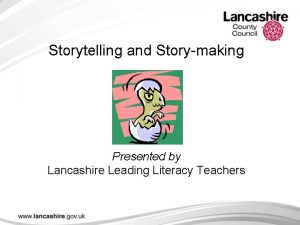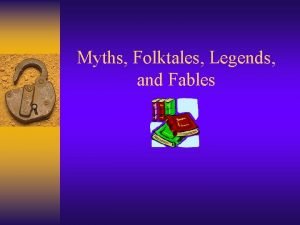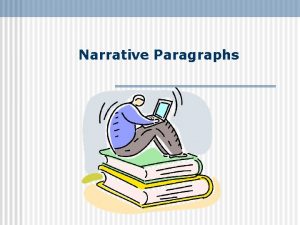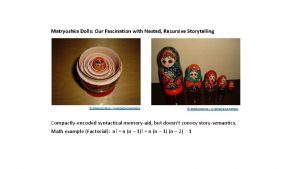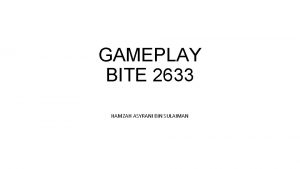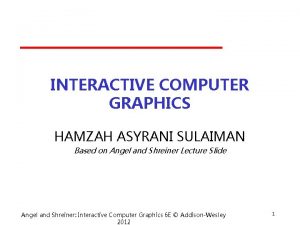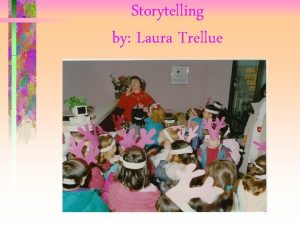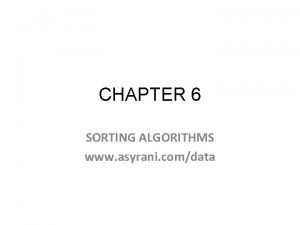Storytelling hamzah asyrani sulaiman Storytelling is a feature





















- Slides: 21

Storytelling hamzah asyrani sulaiman

Storytelling is a feature of daily experience. We do it without thinking about it when we recount some experience we have had, whether it is the story of how the golf match went with our friends, or a fiction made up for story time with our children

Why Put Stories in Games?

Stories can add significantly to the entertainment that a game offers.

Stories attract a wider audience.

Stories help keep players interested in long games.

Stories help to sell the game.

The following factors affect how much of a story a game should include, and you should take them into account when you make your decision: Length Characters Degree of realism. Emotional richness

Key Concepts

Story or not to story? In the loosest definition, a story is an account of a series of events, either historical or fictitious Story

REQUIREMENTS OF GOOD STORIES For the purpose of putting good stories into games, we need to expand the original definition beyond “an account of a series of events. ” A minimally acceptable story, then, must be credible, coherent, and dramatically meaningful.

INTERACTIVE STORIES In English, stories—even those set in the future—are normally written using the past tense. An interactive story, on the other hand, takes place now, with the player in the middle of the series of events, moving forward through those events. Furthermore, the player’s actions form part of the story itself, which makes an interactive story very different from a story presented to a passive audience. In fact, an interactive story includes three kinds of events Heavy Rain Player events In-game events Narrative events

The definition of narrative is open to debate, but this book uses a definition that conforms pretty closely to that used by theorists of storytelling. Narrative consists of the text or the discourse produced by the act of narration. In an interactive story, narrative is the part of the story that you, the designer, narrate to your player—as opposed to those actions that the player performs, or those events that the core mechanics create. NARRATIVE The term narrative refers to story events that are narrated—that is, told or shown—by the game to the player. Narrative consists of the noninteractive, presentational part of the story Narrative

THE ROLE OF NARRATIVE The primary function of narrative in a video game is to present events over which the player has no control. Typically these events consist of things that happen to the avatar that the player cannot prevent and events that happen when the avatar is not present, but we still want the player to see or to know about them. Scenes depicting success or failure are usually narrative events.

COMMONLY USED NARRATIVE BLOCKS Many video games use blocks of narrative material—brief episodes of noninteractive content—to tell parts of the story. http: //www. gamasutra. com/blogs/Altug. Isigan/20100922/88114/Cursor_in_Fabula. php

FORMS OF NARRATIVE Narrative in a video game can take many forms. A prerendered movie, a cutscene displayed by the graphics engine, scrolling text that introduces a mission, voiceover commentary that explains the backstory of the game, or even a long monolog by a character can all be considered narrative elements of the game.

BALANCING NARRATIVE AND GAMEPLAY Because playing games is an active process and watching a narrative is a passive one, the player notices the difference between them. A simple arcade game such as Tempest presents no narrative—it is entirely gameplay. A novel or a movie offers no gameplay— it is entirely narrative. The more narrative you include, the more the player sits doing nothing, simply observing your story.

Many designers are led astray by a false analogy between two superficially similar concepts, dramatic tension and gameplay tension. This section defines these terms, discusses their role in entertaining the player, and explains why you shouldn’t confuse them. Dramatic Tension and Gameplay Tension

DRAMATIC TENSION When a reader reads (or a viewer watches) a story, she feels dramatic tension, the sense that something important is at stake coupled with a desire to know what happens next. (Screenwriters call this conflict, but game developers use conflict to refer to the opposition of hostile forces in a game and prefer dramatic tension, which is more accurate in any case. )

GAMEPLAY TENSION When a player plays a game, he feels gameplay tension, also a sense that something important is at stake and a desire to know what happens next. But gameplay tension arises from a different source than dramatic tension does; it comes from the player’s desire to overcome a challenge and his uncertainty about whether he will succeed or fail. In multiplayer games, the player’s uncertainty about what his opponents will do next also creates

THE FALSE ANALOGY Game designers have tended to perceive an analogy between dramatic tension and gameplay tension, as if the two terms simply denoted the same feeling. However, the analogy is a false one. Dramatic tension depends on the reader’s identification with a character (or several of them) and curiosity about what will happen to that character. Darts player feels gameplay tension in wondering whether he can hit the bull’s-eye, but that situation provides dramatic tension only if the outcome matters to a character in the context of a story.
 Hamzah bin abdul muthalib dipersaudarakan dengan
Hamzah bin abdul muthalib dipersaudarakan dengan Suad sulaiman
Suad sulaiman Peta konsep tentang beriman kepada kitab-kitab allah
Peta konsep tentang beriman kepada kitab-kitab allah Isolated feature combined feature effects
Isolated feature combined feature effects Feature dataset vs feature class
Feature dataset vs feature class Digital storytelling rubric
Digital storytelling rubric Ancient greek puppets
Ancient greek puppets Data storytelling with power bi
Data storytelling with power bi Digital storytelling meaning
Digital storytelling meaning Storytelling canvas example
Storytelling canvas example God of storytelling
God of storytelling Adobe spark presentation examples
Adobe spark presentation examples Storytelling content marketing
Storytelling content marketing The little green dinosaur talk for writing
The little green dinosaur talk for writing Characteristics of legends
Characteristics of legends How to write a narrative paragraph
How to write a narrative paragraph Hikaye tamamlama oyunu
Hikaye tamamlama oyunu Nested loops storytelling
Nested loops storytelling Storytelling for sales professionals
Storytelling for sales professionals Uil music memory practice test
Uil music memory practice test Storytelling randsatd
Storytelling randsatd Storytelling branding eksempel
Storytelling branding eksempel













